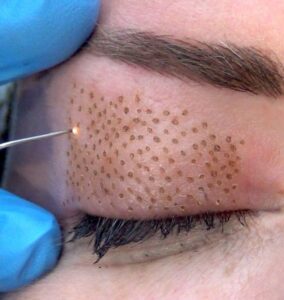This year, we’re offering new and innovative treatments such as fibroblast or plasma lifting procedures — care that helps you feel even more beautiful.
Plasmalift is one of the few non-surgical procedures that tightens the skin and reduces wrinkles, delivering results comparable to cosmetic surgery.
The method is primarily designed for the removal of excess skin and skin tags, smoothing of scars and wrinkles, and overall skin tightening.
HOW DOES IT WORK?
During the procedure, a device powered by electrical energy converts that energy into electrostatic (plasma) energy, which is used to create controlled micro-injuries on the skin. These micro-injuries cause sublimation of the superficial skin layer (epidermis and dermis) — a process where solid tissue transitions directly into a gas — without damaging deeper layers such as the subcutaneous fat.
The result is a series of tiny dots on the skin’s surface, which trigger a natural regeneration process, stimulating the formation of new, healthier skin cells.
During the procedure, a specialized device uses electrical energy, converting it into electrostatic energy (plasma), which creates micro-injuries on the skin. These micro-injuries cause sublimation of the superficial skin layer (epidermis and dermis) — a direct transformation of solid tissue into gas — without damaging the deeper layers such as the subcutaneous fat.
As a result, small carbon dots appear on the surface of the skin, triggering a natural regeneration process and the formation of new, healthier skin cells.
The treatment concludes with a soothing hyaluronic acid mask, which helps calm and nourish the skin.
WOUND HEALING
What happens to your skin after a fibroblast procedure
In short: The fibroblast procedure creates controlled micro-wounds in the skin, which, as they heal, tighten the skin and stimulate new collagen production. The healing process typically takes about 8 days.
While fibroblast is often marketed as a painless procedure with a short 2–3 day recovery time, this is not entirely accurate. Swelling alone can last between 2 to 4 days, and the small scabs (carbon crusts) formed on the skin generally remain for about a week.
So, if you’re told that plasma lifting heals and shows results within 3 days, it’s likely not the real procedure.
That said, the results can be truly impressive — and well worth enduring the 1–2 weeks of redness and scab shedding.
A DEEPER LOOK INTO THE HEALING PROCESS
The “plasma touch” during a fibroblast treatment essentially creates a micro-wound, and the healing process is very similar to that of a conventional wound.
Healing begins immediately after the injury is made — in this case, directly following the creation of the micro-dots using the plasma pen. The speed and nature of healing can vary based on each client’s individual characteristics.
Wound healing occurs in three overlapping and interdependent phases:
Inflammation
Proliferation (new tissue growth)
Maturation (remodeling and strengthening of tissue)
Even micro-wounds (like those from fibroblast or permanent makeup procedures) go through the inflammatory phase, which is the body’s first reaction to tissue injury. This phase peaks around days 3 to 5 post-procedure.
The purpose of inflammation is to protect the area from further damage and to clean the wound of dead cells and pathogens.
Within hours of the wound being created, the body sends white blood cells (leukocytes), neutrophils, monocytes, macrophages, and lymphocytes to the area — all of which play critical roles in initiating and supporting the healing process.

